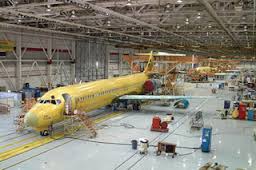
Nature of work
An aerospace engineer designs, develops, constructs, tests, and maintains civil and military aircraft and spacecraft. He/she typically services and maintains aircrafts, measures their performance, and works on improving them. His/her responsibilities include developing navigation instruments and communication systems, designing and maintaining flight simulators, satellites, weapons systems, and supporting the equipments and components of any of these systems. The main tasks that an aerospace engineer carries are finding ways to improve speed, weight, fuel efficiency, and safety, and then implement the improvements. He/she designs prototypes and carries out ground and flight testing programs, and analyzes test data to assess the need for further improvements. His/her jobs can also include assessing the impact that aircraft and air travel have on environment and investigating the causes of aircraft accidents. He/she can specialize in one of many areas of aerospace engineering, such as systems integration, aerodynamics, avionics, materials science, and structural analysis. He/she designs aircraft, spacecraft, satellites, and missiles. In addition, he/she tests prototypes to make sure that they function according to the design. Environment of work
An aerospace engineer now spends more of his/her time in an office than he/she has in the past, because modern aircraft design requires the use of sophisticated computer equipment and software design tools, modeling, and simulations for tests, evaluation, and training. He/she typically works full time. An engineer who directs projects must often works extra hours to monitor progress, to ensure that the design meets requirements, to determine how to measure aircraft performance, to see that production meets design standards, and to ensure that deadlines are met. Professional life
An aerospace engineer has a wide range of jobs to choose like designing, researching, developing the productions, testing, and maintaining. He/she usually finds occupations in the departments of engineering in major airline operators. He/she often works with professionals from related fields, such as mechanical engineers, who design landing gear systems, or electrical engineers, who are typically in charge of the design of aircraft avionics. An aerospace engineer who has significant experience in this field usually becomes a project manager or join consulting firms as a consultant aerospace engineer. An aerospace engineer who know how to use collaborative engineering tools and processes and know about modeling, simulation and robotics will get good opportunities. Also, employees who are trained in computational fluid dynamics software will get a very good opportunities to enabled companies to test designs in digital environment and decreasing the costs of tests.Range of typical starting salaries: 55000 SYP plus potential bonuses.
Getting the job
A person who likes to enter this field should have an academic degree (Bachelor of Engineering, Master of Engineering, master’s degree, and Ph.D. in aerospace engineering. He/she can also enter with a foundation degree. An aerospace engineer usually has a degree in aerospace engineering, air transport engineering or avionics, but can enter the profession with an academic qualification in mechanical engineering, electronic engineering, electrical engineering, manufacturing or product engineering. Additionally, a candidate can be qualified in mathematics, physics, and software engineering. Entry-level to aerospace engineering usually needs a bachelor's degree. High school student who are interested to study aerospace engineering should take courses in chemistry, physics, and mathematics, including algebra, trigonometry, and calculus. At some universities, a student can enroll in a 5-year program that leads to both bachelor’s degree and master’s degree . A graduate degree will allow an engineer to work as an instructor at a university or to do researches and developments. In order to develop his/her professional life, an aerospace engineer should be a member at the Order of Syrian engineers. Skills
A candidate should have many skills, and it is important to improve these skills:Analytical skills, he/she must be able to identify the elements of design that may not meet the requirements in a particular operating environment and then formulate alternatives to improve their performances.
Business skills, most of the work done by aerospace engineers involve meeting federal government standards.
Critical-thinking skills, he/she must be able to ask the right questions and then find the suitable answers.
Math skills, he/she should know how to use the principals of calculus, trigonometry, and other advanced topics in mathematics for analysis, design, and troubleshooting in their work.
Teamwork, he/she must be able to communicate well, divide work into manageable tasks, and work with others toward a common goal.
Writing skills. He/she must be able to write papers that explain his/her designs clearly. They must also create documents for future reference.
Sources and references
If you need any further information on what is included in this file, you can visit the following websites:· www.nasa.gov, www.nasa.gov, National Aeronautics and Space Administration
· magazine.sae.org , Aerospace Engineering Magazine
· The Order of syrian engineers, Damascus, Tel: 6627256
· www.arab-eng.org, Arab Engineers Forum
· Arab Standard Classification of Occupations, 2008, Ed. Arab Labor Organization.
